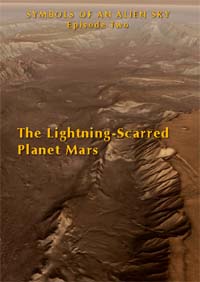|

Red indicates high particle
intensity, blue is low intensity.
The vertical energy scales run from
30 kilo-electron volts to several
mega-electron volts. Credit:
NASA/JPL/APL
Snap Crackle and Spark
Jan
24, 2011
Electric Universe theory
posits that celestial bodies are not
isolated islands in space, they are
connected by current-carrying
electric circuits.
Most of the time planets and
moons are not in a stable electrical
condition because they are moving
across plasma filaments within the
Solar System, or if a moon, in the
plasmaspheres around planets.
The plasmasphere of Saturn
electrifies its environment, causing
dark-mode plasma discharges to
impinge on its family of moons.
Enceladus, Dione and
Tethys are all
electrically active,
flinging vast quantities of charged
particles into space. Each moon is
connected to its parent and to one
another through the aforementioned
circuits.
Planets with magnetic fields can
trap fast-moving particles to form
giant electrified clouds, more
accurately called electric currents.
NASA scientists have noted that
Saturn's magnetic field bends around
Enceladus "due to electric currents
generated by the interaction of
atmospheric particles and the
magnetosphere of Saturn." Further
flattening of the plasma torus on
the sunward side demonstrates an
electrical effect is occurring
between Saturn and the Sun.
According to a recent
press release, NASA
scientists have found a direct
relationship "...between mysterious,
periodic signals from Saturn's
magnetic field and explosions of hot
ionized gas, known as plasma, around
the planet."
Researchers discovered plasma
toroids around Saturn that contain
regions of increased charge density
that generate strong periodic
signals in measurements of the
planet's magnetic field. The cyclic
nature of the signals interferes
with charting Saturn's rotational
rate.
The press release goes on to
state that "hot plasma" surrounding
Saturn "explodes," causing magnetic
field lines to stretch. Centrifugal
force initiated by "cold dense"
plasma erupting from Enceladus
stretches them to the point where
they "snap back," releasing heat.
The process is also known as
"magnetic reconnection."
As the consensus view states,
planetary magnetospheres deform like
teardrops because they are bombarded
by a powerful stream of charged
particles that crackle out from the
Sun. As the fields are pushed on the
sunward side of a planet, they
stretch out on the other side, where
they are said to "unravel" and "flap
like a flag waving in the wind."
According to theory, when those
magnetic field lines cross and
"reconnect" through some unknown
mechanism, they detonate, releasing
large quantities of heat, light, and
electrical energy.
However, magnetic field lines
cannot be the storehouse for
so-called "magnetic energy" because
the field lines are no more real
than the arrows used to describe an
electric field, or the curved lines
that indicate highs and lows on a
weather map. Besides, a magnetic
field is a continuum for all
practical purposes, it is not
quantized into discrete bands.
To say that magnetic field lines
can cross, or flap, or break and
reconnect is tantamount to saying
that weather diagrams can produce
rain.
Retired professor of Electrical
Engineering
Don Scott writes about
the other feature thought to be
"mysterious" by the data analysts:
the "clump" of electrified particles
synchronized with the planet's
rotation.
"I do feel they would stand a
better chance [of understanding] if
they would recognize how magnetic
and electric fields interact with
streams of charge. Nearby electric
current can distort a magnetic
field. A congestion of electric
charge may be due to a concentrated
electric field along some particular
radius vector emanating up from the
planet."
Every so often Saturn breaks out
with a
"great white spot" three
times larger than Earth. Standard
models of Saturn cannot explain such
a spark, but an intense lightning
discharge deep in its atmosphere
might create vertical jets similar
to the sprites in
Earth's upper atmosphere.
It seems as if all the phenomena
that NASA finds so mysterious can be
explained through one agency:
electricity.
Stephen Smith
Multimedia

The Lightning-Scarred Planet Mars
Symbols of an Alien Sky
DVD episode 2
A video documentary that could change everything you thought you knew
about ancient times and symbols.
The Symbols of an Alien Sky video series will introduce you to celestial
spectacles and earth-shaking events once remembered around the world.
Archaic symbols of these events still surround us, some as icons of the
world’s great religions, though the origins of the symbols appear to be
lost in
obscurity.
In this second episode of Symbols of an Alien Sky, David
Talbott takes the viewer on an odyssey across the surface of Mars.
Exploring feature after feature of the planet, he finds that only
electric arcs could produce the observed patterns. The high resolution
images reveal massive channels and gouges, great mounds, and crater
chains, none finding an explanation in traditional geology, but all
matching the scars from electric discharge experiments in the
laboratory.
(Approximately 85 minutes) See:
Lightning-Scarred
Planet info
|








